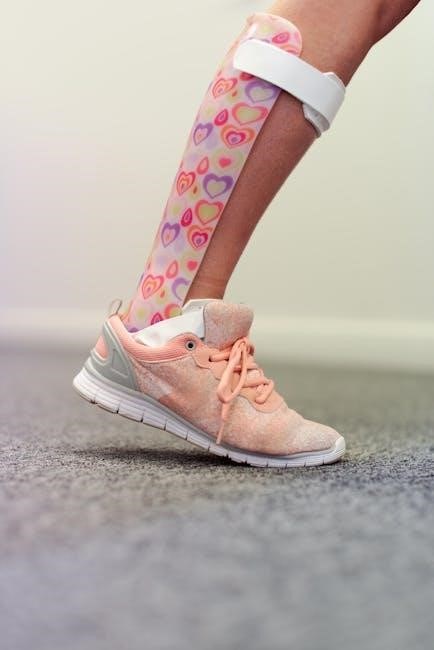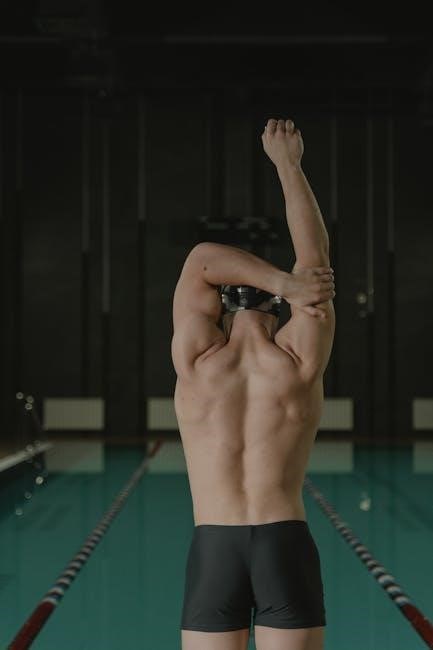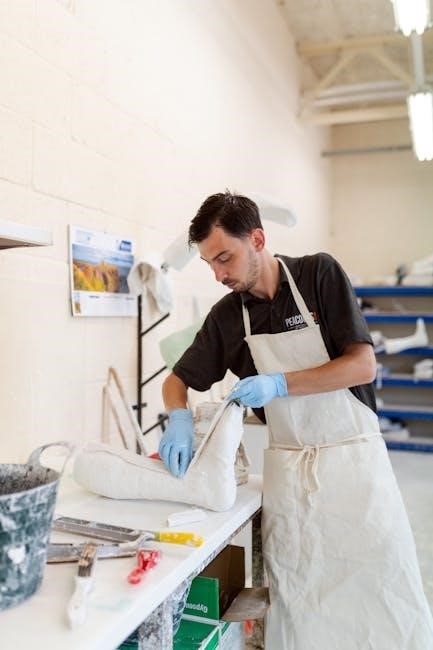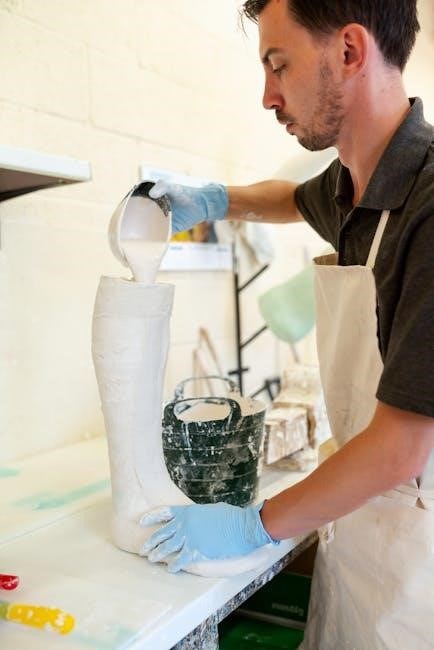A TLSO (Thoracolumbar Sacral Orthosis) brace is a back support device prescribed to stabilize the spine after surgery or for conditions like scoliosis or fractures. This guide provides detailed instructions on proper usage, care, and maintenance to ensure optimal support and comfort.
1.1 What is a TLSO Brace?
A TLSO (Thoracolumbar Sacral Orthosis) brace is a custom-made orthopedic device designed to provide spinal support and stability. It extends from the thoracic region (chest area) to the sacral region (lower back) and is typically used after spinal surgery, for scoliosis, fractures, or conditions like kyphosis. The TLSO brace limits motion in the thoracic, lumbar, and sacral spine, helping to promote proper healing and alignment. It is worn snugly against the body, often over thin clothing, and is made of durable materials for long-term use and support.
1.2 Purpose of TLSO Brace Instructions
The purpose of TLSO brace instructions is to guide patients on the proper use, care, and maintenance of their thoracolumbar sacral orthosis. These instructions ensure the brace is worn correctly, providing optimal spinal support and alignment. They also help prevent complications, such as skin irritation or brace malfunction, by emphasizing proper fitting and adjustment. By following the instructions, patients can maximize the effectiveness of their TLSO brace, promote healing, and maintain comfort during recovery. The guide also addresses troubleshooting common issues and when to seek professional assistance, ensuring safe and successful brace use;
Putting on the TLSO Brace
Properly donning the TLSO brace ensures spinal alignment and comfort. Start by standing upright, then carefully wrap and secure the brace, adjusting straps for a snug fit.
2.1 Step-by-Step Guide to Donning the TLSO Brace
Begin by preparing the TLSO brace and ensuring all straps are loose. Stand upright and place the brace around your torso, aligning it with your spine. Wrap the front section securely, fastening the straps from bottom to top. Tighten each strap evenly to avoid asymmetry. Adjust the shoulder straps for comfort and proper posture support. Ensure the brace sits snugly without restricting breathing or movement. Double-check all fasteners to confirm they are securely closed. If discomfort occurs, make subtle adjustments to achieve a balanced fit. Proper donning is crucial for spinal stability and comfort.
2.2 Tips for Proper Fit and Comfort
Ensure the TLSO brace fits snugly but not overly tight, allowing for natural breathing and movement. Use breathable, moisture-wicking clothing underneath to prevent skin irritation. Adjust straps evenly to distribute pressure uniformly across your torso. Avoid overtightening, as this can restrict circulation or cause discomfort. Regularly check the fit, especially if weight changes occur. Maintain proper posture while wearing the brace to maximize its supportive benefits; If padding shifts, reposition it to avoid pressure sores. For optimal comfort, stand, sit, and move to ensure the brace feels balanced in all positions. Address any tightness or restriction promptly to prevent long-term issues.
2.3 Common Mistakes to Avoid When Putting On the Brace
Avoid rushing the process, as improper alignment can reduce effectiveness. Never bend at the waist while donning the brace, as this can misalign the structure. Do not fasten straps in the wrong order, as this may lead to uneven pressure. Over-tightening can restrict movement and cause discomfort. Not ensuring the brace is centered on the spine can compromise support. Ignoring proper posture during donning can result in poor fit. Always double-check the alignment and fit before securing the brace to avoid issues like poor posture or discomfort during use.

Taking Off the TLSO Brace
Remove the TLSO brace carefully to avoid discomfort or injury. Loosen straps gradually, starting from the bottom for even pressure relief. Maintain proper posture during removal to prevent spinal misalignment. Handle the brace gently to preserve its structural integrity and ensure continued effectiveness. Always store the brace properly after removal to maintain its shape and hygiene. Avoid sudden movements that could cause strain or damage to the brace or your body.
3.1Safe Removal Techniques
3.1 Safe Removal Techniques
To safely remove the TLSO brace, start by loosening the straps gradually, beginning at the bottom to prevent pressure imbalance. Stand or sit upright, maintaining proper spinal alignment. Carefully unlatch closures and slide the brace off without bending or twisting. Avoid pulling too forcefully, which could cause discomfort or skin irritation. If the brace feels stuck, gently rock it back and forth while lifting. After removal, inspect the brace for proper alignment and ensure no components are bent or damaged. Store the brace flat to maintain its shape and prevent warping;
3.2 Post-Removal Skin Care and Inspection
After removing the TLSO brace, proper skin care is essential to prevent irritation and ensure comfort.
- Inspect the skin for redness, sores, or indentations, especially in areas where the brace applies pressure.
- Wash gently with mild soap and lukewarm water to remove sweat and bacteria that can cause skin issues.
- Pat dry thoroughly to prevent moisture buildup, which can lead to fungal growth or skin breakdown.
- Apply a lightweight, non-greasy moisturizer to hydrate the skin, avoiding heavy lotions that might cause irritation;
- Avoid wearing tight clothing immediately after removal to reduce friction and allow the skin to breathe.
- Monitor the skin’s condition and seek medical advice if you notice any signs of pressure sores or persistent discomfort.
Regular skin care helps maintain hygiene, supports healing, and ensures continued comfort while using the brace.

Care and Maintenance of the TLSO Brace
Regularly clean and inspect the TLSO brace to ensure durability and hygiene. Store it in a dry, cool place when not in use to prevent damage. Avoid exposure to extreme temperatures or harsh chemicals, as this can compromise the material integrity. Check for wear and tear, addressing any issues promptly to maintain proper support and function.
4.1 Cleaning the TLSO Brace
Cleaning the TLSO brace is essential for maintaining hygiene and preventing odor buildup. Use a mild soap solution and warm water to gently wipe down the brace, paying attention to areas with padding or straps. Avoid using harsh chemicals, abrasive materials, or excessive water, as this may damage the brace’s components. For tough stains, lightly scrub with a soft cloth before rinsing thoroughly. Allow the brace to air dry completely, away from direct sunlight, to prevent warping or discoloration. Regular cleaning ensures optimal comfort and prolongs the brace’s lifespan.
4.2 Storing the Brace When Not in Use
When not in use, store the TLSO brace in a cool, dry place to prevent moisture buildup and damage. Lay the brace flat or hang it to maintain its shape. Avoid folding or bending, as this may warp the structure. Use a breathable cloth or cover to protect it from dust. Do not store the brace in direct sunlight, as it may cause material degradation. Keep it away from children and pets to avoid accidental damage. Ensure the storage area is clean and free from humidity to preserve the brace’s integrity and longevity when not worn.
4.3 Regular Inspection and Repair
Regularly inspect the TLSO brace for signs of wear, such as cracks, frayed straps, or worn padding. Check for proper alignment and ensure all components are secure; Clean the brace before inspection to accurately assess its condition. If damage is found, discontinue use and contact your orthotist for repairs. Avoid attempting DIY fixes, as this may compromise the brace’s structural integrity. Schedule professional inspections every 3-6 months or as recommended by your healthcare provider. Prompt repairs ensure the brace continues to provide optimal support and prevent further issues from developing over time.

Wearing Instructions for the TLSO Brace
Wear the TLSO brace as instructed, ensuring proper positioning and snug fit without restricting breathing or causing discomfort. Avoid tight clothing that may irritate skin.
5.1 Recommended Duration of Use
The TLSO brace should be worn for 16–22 hours daily, as prescribed by your doctor or orthotist. Consistent use is key for optimal spinal support and correction. Remove the brace only for short periods, such as bathing or sleeping, unless instructed otherwise. Adherence to the recommended duration ensures proper alignment and prevents setbacks in treatment. Always follow your specific prescription, as wear time may vary based on your condition and progress. Brief breaks can help maintain skin health, but prolonged removal may reduce effectiveness. Prioritize comfort while ensuring the brace remains worn as directed for best results.
5.2 Proper Tightness and Adjustment
The TLSO brace should be snug but not overly tight, allowing for proper breathing and movement. Adjust the straps or Velcro closures to achieve even pressure across the torso. Check tightness by ensuring two fingers can fit comfortably between the brace and your skin. Avoid overtightening, as this may restrict circulation or cause discomfort. Adjustments should be made while standing to ensure proper spinal alignment. If the brace feels too tight or causes pain, loosen the straps slightly. Regularly inspect and adjust the fit to accommodate any changes in body shape or comfort needs. Proper adjustment ensures optimal support and prevents complications.
5.3 Clothing to Wear Under the Brace
Wear soft, breathable clothing made of cotton or moisture-wicking fabrics under the TLSO brace to ensure comfort and prevent skin irritation. Avoid tight or rough fabrics that may cause discomfort or abrasions. Opt for snug-fitting undergarments or shirts that will not bunch up under the brace. Layering thin, breathable fabrics can help manage moisture and reduce friction. Ensure clothing does not have seams or tags that could press against the skin. Avoid wearing anything too bulky, as it may interfere with the brace’s fit. Proper under-clothing choices help maintain comfort and prevent skin issues during extended wear.
5.4 Activity Restrictions While Wearing the Brace
While wearing the TLSO brace, avoid activities that involve heavy lifting, bending, or twisting, as these may compromise its effectiveness or lead to injury. High-impact sports, such as running or jumping, should be avoided unless explicitly permitted by your doctor. Activities requiring excessive movement or flexion of the spine should also be limited. However, light exercises like walking or gentle stretching are usually acceptable. Always adhere to the specific activity guidelines provided by your healthcare provider or orthotist. Consulting with them before resuming any strenuous activity is essential to ensure proper healing and support.

Monitoring and Adjustments
Regularly monitor the TLSO brace fit and comfort, ensuring proper support and alignment. Adjustments may be needed to accommodate changes in your condition or body shape.
6.1 How to Monitor Brace Fit and Comfort
Regularly check the TLSO brace for proper fit and comfort. Ensure the brace aligns correctly with your spine and provides consistent support. Pay attention to any areas of discomfort or pressure. Inspect the skin daily for redness or irritation, especially under straps or pads. Adjust the brace as needed to maintain even pressure and avoid restricted movement. Monitor for changes in posture or mobility that may indicate a need for reevaluation. Keep a log of any issues or discomfort to discuss with your orthotist or healthcare provider. This proactive approach ensures optimal support and prevents potential complications. Regular monitoring is essential for long-term effectiveness.
6.2 Adjusting the Brace for Optimal Support
To adjust the TLSO brace for optimal support, start by ensuring the brace is properly aligned with your spine. Tighten the straps gradually, beginning at the bottom and moving upward to maintain even pressure. Use the provided tools to loosen or tighten screws if needed. Check that the brace does not restrict breathing or movement. Ensure the shoulder straps sit comfortably without digging into your skin. Make adjustments while standing to verify proper posture support. Avoid overtightening, as this can cause discomfort or limited mobility. Adjustments should enhance stability and alignment without compromising comfort or flexibility.

6.3 When to Seek Professional Adjustment
Seek professional adjustment if the TLSO brace feels uncomfortable, causes skin irritation, or restricts movement. If pain persists or worsens, consult your orthotist to ensure proper fit. Significant weight changes or postural shifts may require modifications. If the brace becomes loose or misaligned, professional realignment is necessary. Do not attempt adjustments yourself, as this could compromise the brace’s effectiveness or cause injury. Schedule regular follow-ups with your orthotist to maintain optimal support and address any emerging issues promptly. Professional adjustments ensure continued spinal stability and prevent potential complications.

When to Contact Your Doctor or Orthotist
Contact your doctor or orthotist if you experience skin irritation, increased pain, or if the brace malfunctions. Seek help if the brace no longer fits properly or if adjustments are needed to ensure comfort and effectiveness.
7.1 Signs of Skin Irritation or Pressure Sores
Monitor for redness, itching, or inflammation at the brace’s contact points. Pressure sores may develop as blisters or open wounds. Discontinue brace use immediately if these signs appear. Check areas prone to pressure, such as the waist, hips, and armpits. Proper fit and regular inspections can prevent skin issues. Contact your doctor or orthotist promptly to address irritation and avoid further complications. Early intervention ensures skin health and maintains brace effectiveness. Always prioritize skin integrity for optimal TLSO brace outcomes.
7.2 Brace Malfunction or Damage
If the TLSO brace shows signs of damage, such as cracks, broken straps, or misaligned parts, discontinue use immediately. Malfunction can compromise spinal support and lead to injury. Inspect the brace regularly for wear and tear, especially in high-stress areas like hinges or buckles. Contact your orthotist promptly for repairs or replacements. Avoid attempting DIY fixes, as this may worsen the issue. Proper maintenance ensures the brace functions correctly and safely. Addressing malfunctions early prevents further complications and maintains the brace’s effectiveness in spinal stabilization.
7.3 Increased Pain or Discomfort
If you experience increased pain or discomfort while wearing the TLSO brace, stop use and consult your orthotist or doctor immediately. This could indicate improper fit, excessive tightness, or underlying issues. Check for redness, swelling, or numbness, which may suggest pressure points. Adjustments or padding may be needed to alleviate discomfort. Persistent pain could hinder recovery and require professional evaluation. Addressing discomfort early ensures continued spinal support and promotes healing. Do not ignore worsening symptoms, as they may indicate a need for brace modification or alternative treatment options.

Troubleshooting Common Issues
Identify and address common TLSO brace issues promptly to ensure proper fit and comfort. Check for tightness, alignment, and skin irritation. Adjust as needed or consult professionals.
8.1 Resolving Fit Issues

If the TLSO brace feels too tight or loose, adjust the straps gradually. Ensure proper alignment by checking the brace’s position on your body. Avoid overtightening, as this can cause discomfort or restrict breathing. If the brace shifts during wear, reposition it carefully and secure the straps. Persistent fit issues may require professional adjustment. Always ensure the brace is snug but not constricting. Proper fit is essential for effective support and to prevent complications. Consult your orthotist if adjustments do not resolve the issue.
8.2 Addressing Skin Irritation
If you experience redness, pressure sores, or discomfort, inspect the affected area; Clean it with mild soap and pat dry. Apply a fragrance-free moisturizer to soothe irritation, avoiding areas where the brace touches the skin. Ensure the brace fits properly and isn’t too tight. Wear breathable, moisture-wicking clothing underneath. If irritation persists, consult your orthotist for adjustments. Avoid prolonged wear without breaks, as this can exacerbate irritation. Proper care and fit adjustments can prevent further discomfort and promote healing.

8.3 Managing Brace-Related Discomfort
To manage discomfort from the TLSO brace, start by identifying the source. Check for improper fit or excessive tightness. Loosen straps slightly if needed, but ensure stability isn’t compromised. Use padding or cushioning where pressure points occur. Take regular breaks to allow skin to breathe and muscles to relax. Avoid over-tightening, as this can restrict movement and cause pain. If discomfort persists, consult your orthotist for adjustments. Proper fit and periodic breaks are key to minimizing brace-related discomfort and ensuring long-term comfort and support.
Adhering to TLSO brace instructions ensures proper support, comfort, and spinal alignment. Consistent use and maintenance promote optimal results. Consult professionals for adjustments and guidance.
9.1 Importance of Following TLSO Brace Instructions
Following TLSO brace instructions is crucial for ensuring proper spinal alignment, promoting healing, and preventing complications. Adherence to guidelines helps maintain optimal support and comfort, reducing the risk of skin irritation or brace malfunction. Consistent use as directed by healthcare professionals ensures the brace functions effectively, supporting your recovery journey. Proper fit and regular inspections are essential for long-term success. Neglecting instructions can lead to discomfort or prolonged recovery. Always prioritize professional advice and maintain a proactive approach to brace care for the best outcomes.
9.2 Final Tips for Successful Brace Use
To ensure successful TLSO brace use, prioritize proper posture and maintain regular follow-ups with your orthotist. Keep the brace clean and dry to prevent odor and skin issues. Avoid tight clothing that may cause discomfort or irritation. Stay active within recommended limits to support overall health. Listen to your body and report any unusual pain or discomfort promptly. Consistency in wearing the brace as prescribed is key to achieving desired outcomes. Stay positive and committed to your treatment plan for the best results and a smoother recovery journey.